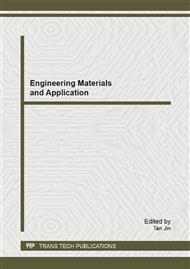[1]
Dreesen Laurent, Colomer Jean-François, Limage Hervé, Giguere Alexandre, Lucas Stephane. Synthesis of titanium dioxide nanoparticles by reactive DC magnetron sputtering [J]. Thin Solid Films, 518 (2009) 112-114.
DOI: 10.1016/j.tsf.2009.06.044
Google Scholar
[2]
R. Asahi, T. Morikawa, T. Ohwaki, K. Aoki and Y. Taga, R. Asahi, T. Morikawa, T. Ohwaki, K. Aoki and Y. Taga. Visible-Light Photocatalysis in Nitrogen-Doped Titanium Oxides [J]. science, 293 (2001) 269-271.
DOI: 10.1126/science.1061051
Google Scholar
[3]
Yazhou Lu, Zumin Qiu, Preparation and Photocataiytic Activity of Pb2+-SiO2-TiO2 Composite Catalyst, Journal of Nanchang University (Engineering & Technology), 33 (2011) 112-116, (in chinese).
Google Scholar
[4]
I Sopyan, M Watanabe, S Murasawa, K Hashinoto, A Fujishima. An efficient TiO2 thin-film photocatalyst: Photocatalytic properties in gas-phase acetaldehyde degradation [J] Electroanlytical Chemistry, 1/2 (1996) 79-86.
DOI: 10.1016/1010-6030(96)04328-6
Google Scholar
[5]
C J Brinker, A J Hurd, P R Schunk, G C Frye, C S Ashley. Review of sol-gel thin-film formation, J Non-Cryst Solids, 147 (1992) 424-436.
DOI: 10.1016/s0022-3093(05)80653-2
Google Scholar
[6]
M S Jeon, W S Yoon, H Joo, T K Lee, H Lee. Preparation and characterization of a nano-sized Mo/Ti mixed photo catalyst [J]. Appl. Surf. Sci., 65 (2000) 209.
DOI: 10.1016/s0169-4332(00)00495-5
Google Scholar
[7]
D. de la Cruz Romero, G. Torres Torres, J. C. Are´valo, R. Gomez and A. Aguilar-Elguezabal, Synthesis and characterization of TiO2 doping with rare earths by sol–gel method: photocatalytic activity for phenol degradation [J]. J Sol-Gel Sci Technol, 56 (2010).
DOI: 10.1007/s10971-010-2297-3
Google Scholar
[8]
U.M. Khan Shahed, Sultana Tamanna, Photoresponse of n-TiO2 thin film and nanowire electrodes, Solar Energy Materials & Solar Cells, 76 (2003) 211–221.
DOI: 10.1016/s0927-0248(02)00394-x
Google Scholar
[9]
Y Xie, C. Yuan. Characterization and photocatalysis of Eu3+ TiO2 sol in the hydrosol reaction system. Mater. Res, Bull, 39 (2004) 533.
DOI: 10.1016/j.materresbull.2004.01.001
Google Scholar
[10]
J Choi, H Park, M R Hoffmann. Effects of single metal-ion doping on the visible-light photoreactivity of TiO2[J]. J Phys Chem C, 114 (2010) 783-792.
DOI: 10.1021/jp908088x
Google Scholar
[11]
Xinshu Niu, Sujuan Li, Huihui Chu, Jiangguo Zhou. Preparation, characterization of Y3+-doped TiO2 nanoparticles and their photocatalytic activities for methyl orange degradation. [J]. Journal of rare earths, 29 (2011) 224-225.
DOI: 10.1016/s1002-0721(10)60435-8
Google Scholar
[12]
K. T Ranjit; I Willner; S H Bossmann, et al. Lanthanide Oxide Doped Titanium Dioxide Photocatalysts: Effective Photocatalysts for the Enhanced Degradation of Salicylic Acid and t-Cinnamic Acid [J], Journal of Catalysis, 204 (2001) 305-313.
DOI: 10.1006/jcat.2001.3388
Google Scholar
[13]
Mengwei Xue, Youhong Sun, Aifeng Yu. Effect of TiO2 photocatalysts doped with lanthanum on methylene blue solution photolytic activity [J]. Chemical Industry Times, 19(2005) 6-8.
Google Scholar
[14]
E W Chen, D H Yin, J Song, Preparation of lanthanide ions-doped TiO2 and its photocatalytic activity for imidazole degradation [J]. Chinese Journal of Catalysis, 27 (2006) 344-348.
Google Scholar
[15]
Jun Du, Piyi Du, Ming i, Xu Zhude. Effect of lanthanum doping on the photocatalytic activity of titanium dioxide [J]. Acta Physico Chimica Sinica., 5 (2000) 462.
Google Scholar
[16]
J.O. Carneiro, V. Teixeira, A. Joao, A Magalhaes, C J Tavares. Study of Nd-doping effect and mechanical cracking on photoreactivity of TiO2 thin films. Vacuu, 82 (2008) 1475-1481.
DOI: 10.1016/j.vacuum.2008.03.013
Google Scholar


